by Marta Jecu // Sept. 20, 2011
I met Tjorg Douglas Beer last year for a discussion regarding the Kreuzberg Biennial in his atelier, which had hosted some nights before its grand party of inauguration with all Kreuzberg friends, strollers, performers, bar and project space keepers, park and party goers. The interview finally span not on but in the biennial: Tjorg brought the talk on the street and parcoursing the neighborhood, made us see the invisible biennial in old shops with sculptures mingled in the ordinary display, ephemeral constructions up in trees, art videos on the surveillance cameras of tobacconists, mysterious urban vestiges in bookshops between the books, message boards sunk deep inside a zen pond nobody knew existed in the yards behind the Kanal, films with animals by Christoph Schlingensief shown in the local amphibian pet shop. The works seemed not punctually dis-played in open air, but making sense only in geographical relation to each other, connected by shortcuts that you didn’t knew before in Kreuzberg. The same night, the tiny Forgotten Bar Project in Boppstr. 5 inaugurated an exhibition for a night, in a movement that instead of consuming, is releasing free space, by constantly refreshing the frameworks and preventing the infrastructure to swallow its own subject content. The above discussion has been updated with new infos on recent projects, which Tjorg Douglas Beer conceives now in/from Athens.
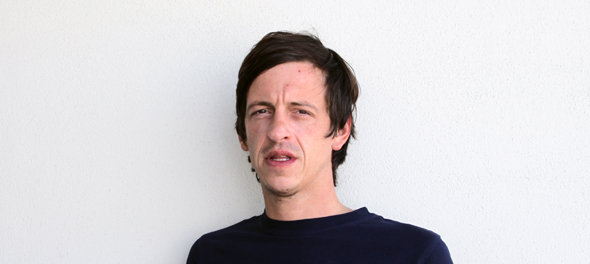
Tjorg Douglas Beer, Portrait 2011; Courtesy Galerie Utopia
Tjorg Douglas Beer was born 1973 in Lübeck, grew up and studied in Hamburg. His work is shown in Kunstverein Hamburg, Museum für Moderne Kunst, Kunsthalle Wien, Timothy Taylor Gallery, London, Tate Modern, London, X-Initiative, New York, Hokkaido Museum of Modern Art, Sapporo, with solo-shows in Kunsthaus Hamburg, Kunstraum Innsbruck, Stadsgalerij Heerlen, Contemporary Art Institute Sapporo, Mitchell-Innes & Nash, New York. He initiated projects like the Galerie im Regierungsviertel, the Forgotten Bar and Ayran & Yoga – The 1st Berlin Kreuzberg Biennale 2010.
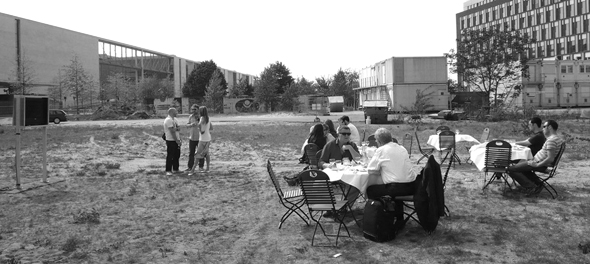
Galerie im Regierungsviertel, Inaugurational Exhibition Area of Governement Adminstration Berlin, 2007 VG Bildkunst Bonn, Tjorg Douglas Beer 2010; courtesy Galerie Utopia
MARTA JECU: I was thinking to have a focus on your vision on Berlin, as you formed it on one hand by curating and organizing exhibitions, galleries, street events here, and on the other hand regarding the urban organisms and configurations in your paintings. We could think about the real city, Berlin and especially Kreuzberg, the part in which you mostly intervene, but also on an imaginary Berlin, or an urban experience of an internalized Berlin, which you work upon in all your projects.
TJORG DOUGLAS BEER: For a start I would like to tell you a bit about the relation between my own work and the projects I´ve been doing with others. Since I have been a student in Hamburg I`ve been dealing with situations and phenomena that I´ve gotten in touch with in real life. I`ve always seen art more as a field to turn these situations into scenarios, like musicians or writers are doing in their texts or songs, rather than behaving like a pseudo-scientist, chasing with big efforts achievements for the further development of art history.
After having experienced a few very interesting years in the art world, as a young artist, including lots of traveling, parties, fairs, I`ve moved to Berlin, which was a place that I expected to give me more freedom and concentration for my work than for example New York was doing. After having lived in Berlin for two years (that for some reason made me behave like I was still in New York – meaning that I was running around Berlin like crazy from opening to opening to opening, to party to party to party, to clubs and bars), I realized that there had to be a change. I was living in Kreuzberg and had very nice working conditions and I loved the neighborhood, due to its great and intense mix of different cultures and people.
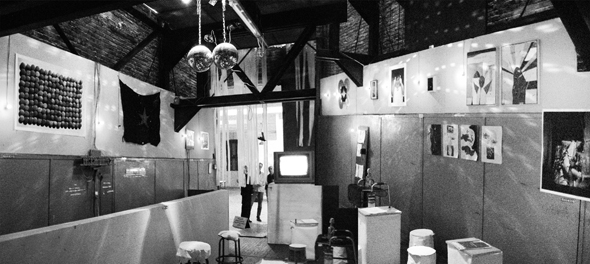
The Forgotten Bar, Installation View, X-Initiative New York, 2009 VG Bildkunst Bonn, Tjorg Douglas Beer 2010; Courtesy Galerie Utopia
In 2007 me and some friends started Galerie im Regierungsviertel. It was a lightbox installed in the area of government administration in Berlin. And we wanted to use it as a flexible tool to do exhibitions with people whose work we appreciated and show in the art context their work that emerged from real life experiences. In 2009 after having done several projects with Galerie im Regierungsviertel I came to the point where I wanted to have a small bar in Kreuzberg, since I thought, that this should be a focuspoint for our activities. We opened the Forgotten Bar Project, where we showed 60 exhibitions in 2 months. In 2009 I reopened the Forgotten Bar and since than we have shown more than 200 exhibitions including more than 2000 artists in one and a half years. This place functioned like a never ending jam session. Almost every night there was another opening and it was becoming a place where you meet people, but also a place where you can find professionally successful works.
This time of intense cooperation with lots of friends and colleagues has led to the decision to do an exhibition in larger scale to celebrate Kreuzberg, our life and work situation and our time of working together. The biennial had to create a common meeting place for the people that generate here in Kreuzberg their work, with the people that interpret it and the people that come to see it, in the very environment where this art was emerging. We called it Ayran & Yoga The 1st Berlin Kreuzberg Biennale. We didn`t have any budget for it, so we decided to concentrate on realizing it in a simple way: We installed about 50 artworks in the Kreuzberg city landscape wherever the artists found spots they liked. The biennial showed that spontaneity, sensibility and swift timing are possible. The works exhibited were mostly very fragile and almost not recognizable without knowing about them. We gave guided tours along the route of works.
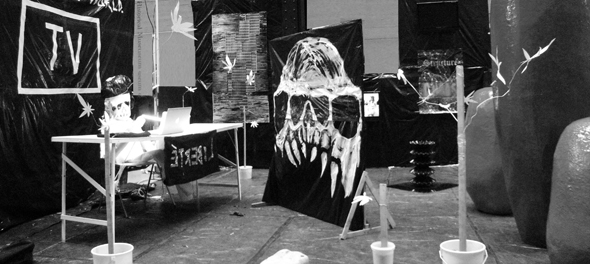
Galerie im Regierungsviertel, The Forgotten Bar, The-New-World.TV, Installation View, Tate Modern, 2010 VG Bildkunst Bonn, Tjorg Douglas Beer 2010; Courtesy Galerie Utopia
The Berlin Kreuzberg Biennale was also an attempt to minimize the effects of the structures that intermediate art and that intensify more and more. Art has indeed a very peculiar mechanic: the writers that write, the collectors that collect, the photographers that make photos, the gallerists that sell, the gallery assistants that have a job at the galleries – all these art intermediators are very hard to get a grasp on, while doing your art.
But why did you call it Biennale? Is it because it takes place one time in 2 years or because you want to create a relation to the Berlin Biennale, with which it took place at the same time.
At least we intend to let it happen for a second time in 2012. The title Biennale is only a formal denomination and a formal value designation for the substance of this exhibition, whereas the title Ayran und Yoga is an ironic manner to comment upon the realities here in Kreuzberg. We can imagine Ayran and Yoga being two boys living in this part of the city, that grew up here and go together to primary school, but which originate from very different places. Ayran and Yoga is the reality here, two possible poles of the reality we are in here, it represents a field of tension, one between many others here in Kreuzberg.
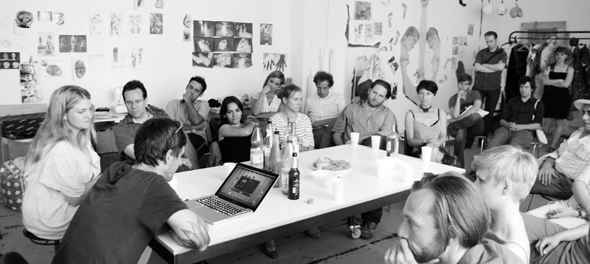
Berlin Kreuzberg Biennale, 2010 VG Bildkunst Bonn, Tjorg Douglas Beer 2010; Courtesy Galerie Utopia
Old neighborhoods, with long phases of development in the history of a city and with interesting social situations, are suddenly surpassed by people with more money than the rest of the population, or from people that suddenly realize that their properties in that place are much more worth. As a consequence everything will change and the originar population will have to move to other neighborhoods. But that is normal and everywhere like this, we can only hope that here in Kreuzberg the culture that emerged in the last decades will not develop in this direction in a very fast tempo, like it happened in other Berlin neighborhoods. Commenting in this direction, is not about expressing self-sufficiency regarding the situation and the place we live in, but about taking into account reality. This is also the thematic field of the Berlin Kreuzberg Biennale. From this point of view, I was talking about Ayran and Yoga, the two boys going to school and strolling together on Urbanhafen.
Our idea of a Biennial was also getting together a lot of works in the open space of the city. Than another urban reality emerges. When you see works, that you initially knew from the gallery, and experience them now here in open air, the works open up in a new way and they provoke new ways of thinking and sometimes what we find is a very simple, poor/unassuming quotidian poetics.
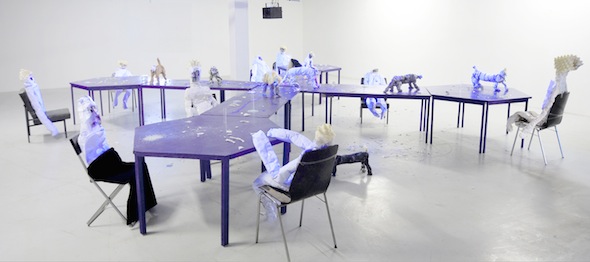
“Diamonds & Bones + The-New-World.TV”, installation view, Kunstraum Insbruck, 2009 VG Bildkunst Bonn, Tjorg Douglas Beer 2010; courtesy Produzentengalerie Hamburg
How do you see the role of the individual and his actions as potential in the city and as part of the structures that surpass him. What is the role which the thinking processes of the individuals have in shaping the city and in which respects he and his imaginary are conditioned by the urban structures themselves?
The world we live in shapes the people very often not really in a positive way. Living conditions make people develop in ways that are not fortunate to more than a minority. On the other hand it is people who define these conditions. I have worked on these phenomena in several bigger works and exhibitions. For me there is no other perspective than the one that the human being is nothing else than a failure in evolution. The size of the human brain in relation to the body size is bigger than in any other creature, humans are developing systems like religion, philosophy, politics and science, which are amazing constructions to try to understand, structure or organize the world and the position and life of the human in it, but if we look at what is happening on this planet, we can only say that these systems are all not coherently functioning. I do not see that the humans are on their way of making this place better. It is rather more the opposite: the world without humans would be a paradise and too often humans turn it into hell. It is a decision that we all have to make: deciding in which way we want to go and take as much energy as possible to stop fitting into the conditions and realities in which we find ourselves and which are defined by corrupt or mistaken thinking and motivations. It is everybody’s responsibility to decide whether we produce more mutation or stop mutants shaping more mutants.
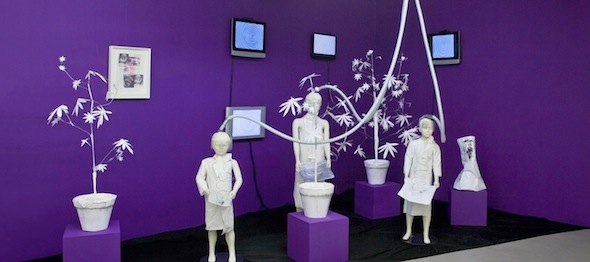
“Central Services”, installation view, Museum für Moderne Kunst Bremen, 2009 VG Bildkunst Bonn, Tjorg Douglas Beer 2010; courtesy Produzentengalerie Hamburg
How are these processes in regard to you and Berlin, personally?
Berlin is just a place that has provided a lot of space and reasonable living conditions for artists and other young people to develop their life. I do not think that there is a big difference to any other social situation on this planet. The problems are the same everywhere and it is more a question of character and personal strength to influence the world around us in a good way, rather than arranging ourself with the realities that are “given”.
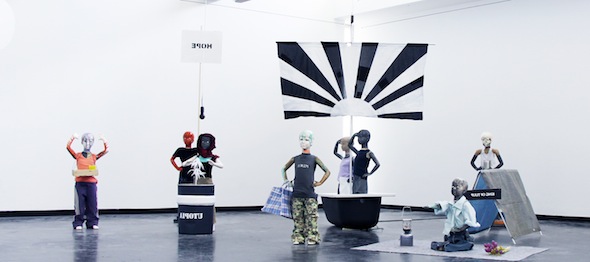
“Future Islands”, installation view, Institut für Moderne Kunst Nürnberg, 2009 VG Bildkunst Bonn, Tjorg Douglas Beer 2010; courtesy Produzentengalerie Hamburg
Talking about your projects which you organize, for instance the Berlin Kreuzberg Biennale and the extra exhibitions in art fairs, you where talking about the need to show more fragile or delicate works of other artists friends and to place these group shows in the art market whose economic values are actually connected to stability and persistence. Besides that your paintings are also very fragile and delicate, what are the roles of fragility and perishability for an urban culture like that of Berlin?
The main problem is that so called values in our world are measured in Dow Jones Indexes, Taxes, selling prizes for artworks and so on. Real values are forgotten. They are discriminated as idealistic bullshit and do not play the role they should, to preserve honorable living and thinking circumstances. In years of an uprising art market, gallerists were selling artworks to whoever was willing to spend whatever amount of money, they made their deals, instead of educating the buyers as potentially interesting collaborators. This attitude is the same that has driven the whole world into the disaster of the last years, a disaster that started in the financial world.
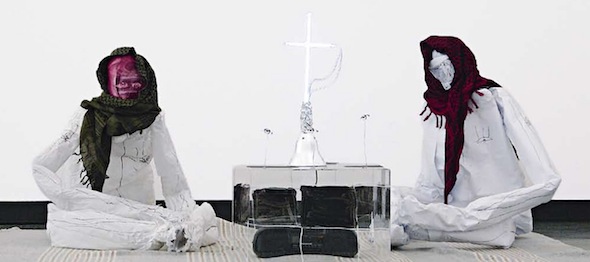
“Maneuvre-Grill”, Installation detail Narkose #02, Stadtsgalerij Heerlen, 2009 VG Bildkunst Bonn, Tjorg Douglas Beer 2010; courtesy Produzentengalerie Hamburg
Any interventionist initiative can be seen like curating the city, forming a space in the urban space, with the same elements, but according to new rules. Regarding Berlin, what curating practices should take place to give expression to potentials that are not yet manifested?
What curating means I have not understood until now. I have only seen a development that generates hundreds of people having studied for example cultural management or other academic constructions in which most of the people coming out of these “Kaderschmieden” (i.e. educational institutions reserved for future political power-holders or protégées) have learned a certain way of dealing with art that unfortunately forgets the necessity of existential values, which should in fact be the basis of appreciation. Instead we are confronted with 25 year old interns that pretend “to have eaten the wisdom with the ladle” (i.e. all at once, without criteria) and try to clone/copy mega-curator’s attitudes from Biesenbachs and Obrists. The misfortune is, that these people often have the intensity of a piece of dry bread and then start telling artists how to do their work. The worst example seen in the last years was the exhibition Based in Berlin. These people should either do some interRail holidays and take a lot of drugs to find themselves, or work as what they are: interns.
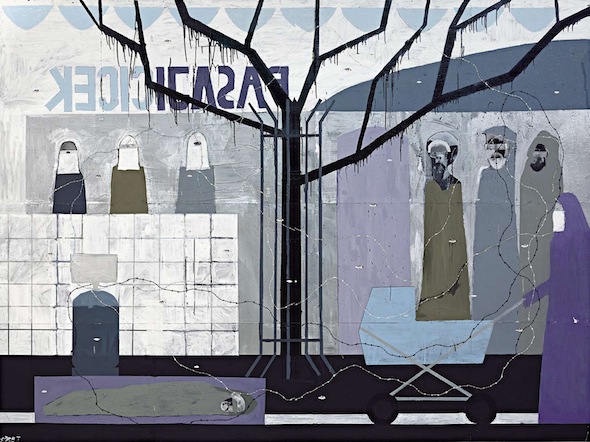
“Pasaji Cicec”, 2009 VG Bildkunst Bonn/ Tjorg Douglas Beer 2010; courtesy Produzentengalerie Hamburg
What is needed are people with character and personality, but these are rare. Besides these things there is always fortunately a big range of people trying new things and finding niches for fantastic projects. Fortunately I have managed to create my own network of adorable and intense people that gives me a lot of independence from all these instances and the freedom to do whatever I want, without the need to arrange myself with this kind of circumstances and people. For me the time in Berlin is finished for now. I went to the two artists bars more than enough times. Galerie im Regierungsviertel is now Galerie Utopia and working elsewhere. The Forgotten Bar Project opens in Athens this September and next year we will be back in Berlin for The 2nd Berlin Kreuzberg Biennale.
A Berlin utopia?
An Utopia for Berlin would be to close down all galleries and bars and breed sheep and goats and let them curate the next Berlin Kreuzberg Biennale.
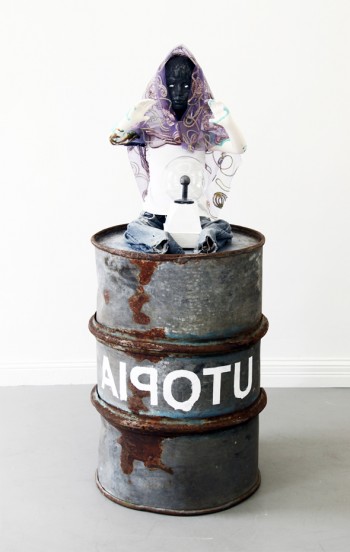
“Utopia”, 2011 VG Bildkunst Bonn, Tjorg Douglas Beer 2011; courtesy Produzentengalerie Hamburg/Galerie Karlheinz Meyer
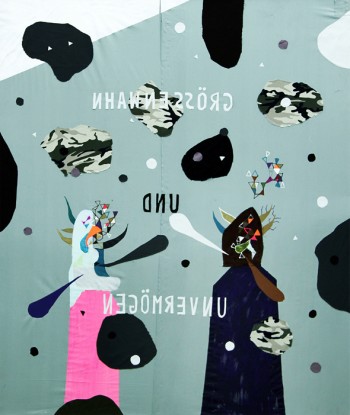
“Grössenwahn und Unvermögen”, 2011 VG Bildkunst Bonn, Tjorg Douglas Beer 2011, courtesy Galerie Karlheinz Meyer
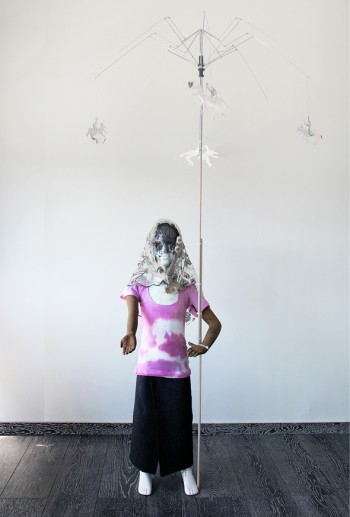
“The Four Horsemen”, 2011 VG Bildkunst Bonn, Tjorg Douglas Beer 2011, ; courtesy Produzentengalerie Hamburg/Galerie Karlheinz Meyer
Author Info
Marta Jecu is presently a researcher at CICANT Institute in Lisbon, and has contributed for various magazines, including E-Flux, Kaleidoscope, Journal of Curatorial Studies, Idea Arta+ Societate, and various critical books, such as Visual Studies, Ed. Jim Elkins.


























